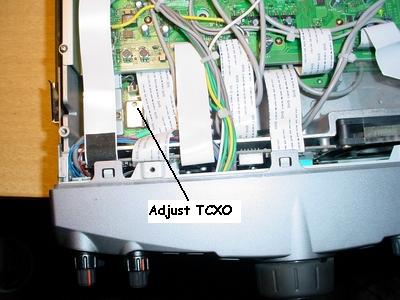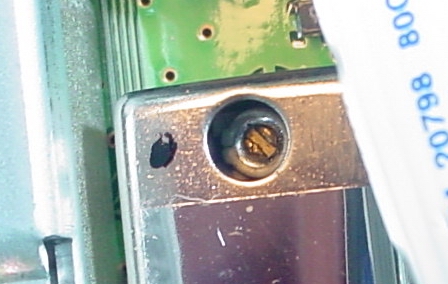
The master oscillator adjustment can be accessed from the bottom. Turn the radio upside down and remove the bottom cover. The photos show the oscillator adjustment point.

| The TS-2000 is a great transceiver but
it is possible for the frequency calibration to be off. I
have heard from owners whose rigs were off from the start
but mine was 'right on ' when new. But after 2 years of
operation I found it to be seriously out of calibration.
The master oscillator adjustment can be accessed from the bottom. Turn the radio upside down and remove the bottom cover. The photos show the oscillator adjustment point.
|
| If you have access to a high quality
calibrated frequency counter you could measure the TCXO
frequency directly. After an hour of hunting on the
schematics I found it and it appears to be at 15.6 Mhz. Another way is to calibrate the receiver against WWV. I found it very difficult to detect zero beat since there is no IF shift available in the TS-2000, so I used the technique described by ZF1DG. Connecting the audio output from the TS-2000 to the sound board of a computer and using the Spectran program, you can see the frequency of an audio tone to within about 1-2 Hertz. WWV alternates between sending a 500 or a 600 Hz tone during each minute, so it is easy to see. First put the receiver in AM mode and look at the tones with Spectran (or some other waterfall program). If the sound board and Spectran are working properly together, the tones should be seen EXACTLY at 500 or 600 hertz. Next switch the receiver to USB and tune the receiver so that the dial reads exactly 5, 10, or 15 Mhz (depending on which WWV frequency you are listening to). Tune using the multi-function knob, set to tune in 10 Khz steps, or enter the frequency directly with the number pad. If you tune with the knob the frequency will not be exact. Now observe the tone with Spectran. It should still be exactly at 500 or 600, but will probably be off a little. Adjust the TCXO until the tone shown in Spectran is exactly 500 or 600 Hertz. Do it carefully. A 1 Hz error here will translate to a 10 to 28 Hertz error at 2 meters (depending on which WWV frequency you are using). And it translates to a 90 to 250 Hz error at 1296). I was unable to get it that close using this technique. I ended up with about a 400 Hz error at 1296, indicating I was about 3 Hz off at 10 Mhz. Fortunately I had a better way available to me and I think it is probably the best of all. I had available a rubidium standard locked oscillator at 1296.0000 Mhz. By adjusting the receiver to 1296.0 and then using the RIT to offset the receiver 1 Khz lower, I was able to generate a 1 Khz tone from the standard signal. Then I adjusted the TCXO so the tone showed exactly 1000 Hertz on Spectran. With a possible error of 2-3 Hz, this means that at 2 meters I should be off no more than 1/3 of a cycle! However the picture is not that rosy. The oscillator has some short term drift due to heating effects. I found that when cool the TS-2000 is about 25 Hz high at 1296, and when hot it runs about 25 Hz low. Still this is not bad and a lot more accurate than most other amateur transceivers. Where did I get the rubidium standard? On the air. In Princeton, NJ there is a 1296 Beacon, W2ETI, run by the SETI League. It transmits a rubidium standard locked carrier at 1296.000000 for the first minute of each 5 minutes whenever the moon is above the horizon in NJ. Fortunately I live about 40 miles from this beacon and it is S9 here. If you aren't lucky enough to live near an atomic standard, you can buy your own for $300 or so, or you can probably take your TS-2000 to a nearby lab where they have standard equipment. Ask around the local hams and see who has access to such a lab. |